Concept of Resistance
Resistance is the opposition of a circuit to the flow of electric current. It limits the current flow: the higher the resistance, the more difficult it is for the current (measured in amperes, A) to circulate. This principle is perfectly illustrated by Ohm's Law (V = R × I). The concept can be understood as follows: the greater the resistance (R), the higher the voltage (V) required to allow a given current (I) to flow.
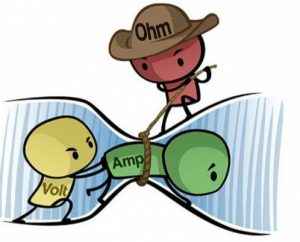 In simple terms, a resistor is an electronic component that limits the flow of electric current.
In the circuit below, it can be observed that the higher the resistance, the harder it is for the current to pass through, resulting in lower brightness. Without the resistor, the LED would simply burn out.
In simple terms, a resistor is an electronic component that limits the flow of electric current.
In the circuit below, it can be observed that the higher the resistance, the harder it is for the current to pass through, resulting in lower brightness. Without the resistor, the LED would simply burn out.
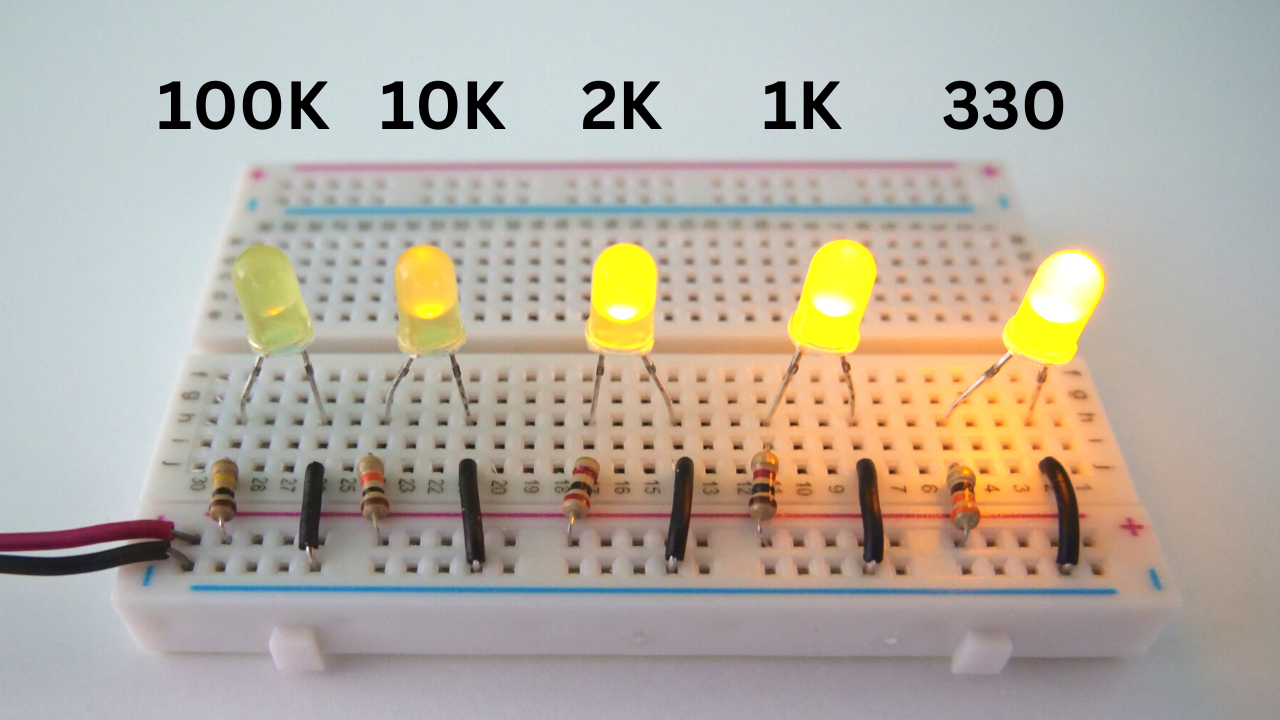
Note: Resistors do not have polarity.
There are various types of resistors, which differ in their shape and functionality. Observe the different types along with their corresponding symbols:
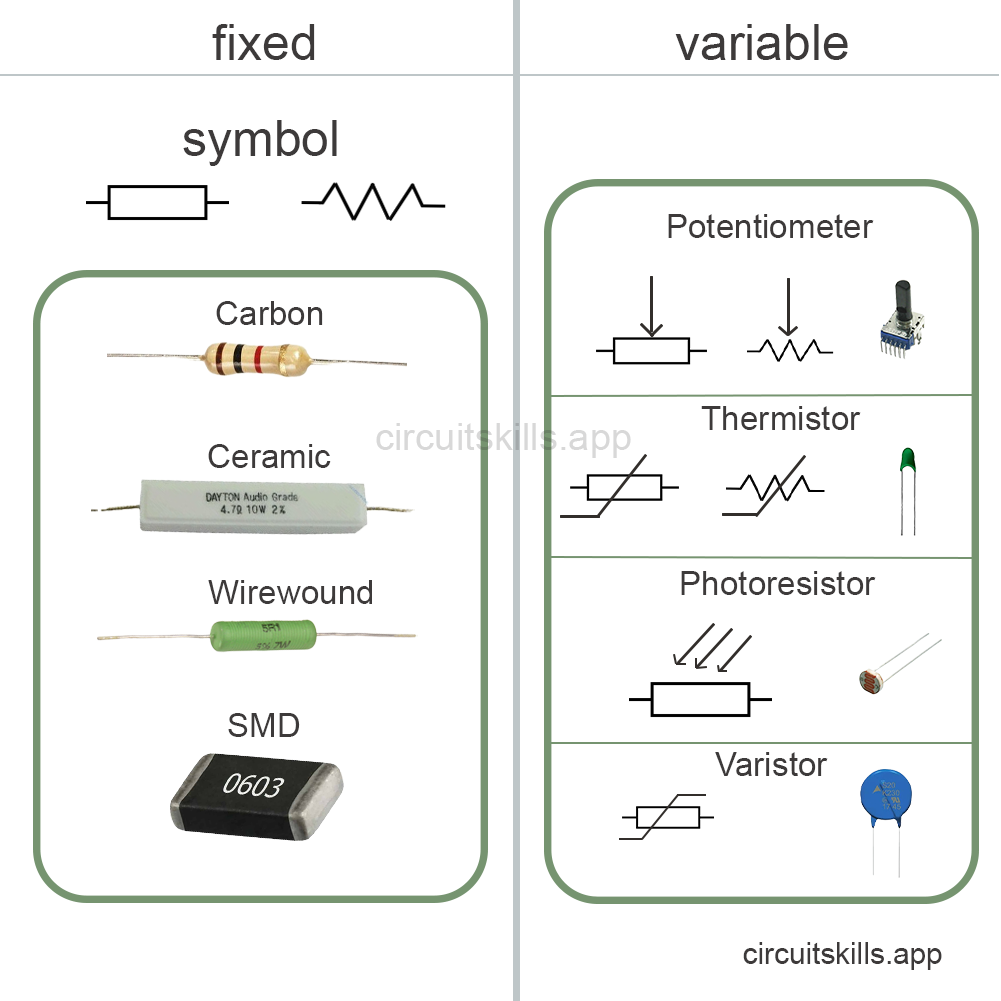
Fixed Resistor.
A fixed resistor is a passive electronic component whose electrical resistance value is constant and cannot be modified. It is designed to provide a precise opposition to the flow of electric current in a circuit, thereby limiting the flow of electrons according to Ohm's Law (V = R × I). Fixed resistors are commonly used to control current, divide voltages, or protect other electronic components. Main Characteristics:
-
1. Fixed Value: The resistance is determined during its manufacturing and does not change.
-
2. Precision: It is often marked by a color code or a numerical value indicating its resistance in ohms (Ω).
-
3. Applications: Used in almost all electronic circuits, from household appliances to industrial systems.
Fixed resistors come in several types, each with specific characteristics suited to particular applications. Here are the main types: -
3, 4, 5, 6 bands
-
Ceramic
-
SMD (Surface Mount Device), etc.
The E6, E12, E24, E48, E96, and E192 resistor series are part of the standardized value series defined by the IEC 60063 standard. These series correspond to standardized resistance values, distributed logarithmically to cover a range of values with a given precision. Here is a detailed explanation of each series:
E6 Series.
- Precision: ±20%
- Number of values per decade:^ 6
- Values: 1.0, 1.5, 2.2, 3.3, 4.7, 6.8
- Use: General applications where high precision is not required.
E12 Series.
- Precision: ±10%
- Number of values per decade: 12
- Values: 1.0, 1.2, 1.5, 1.8, 2.2, 2.7, 3.3, 3.9, 4.7, 5.6, 6.8, 8.2
- Use: Common circuits where moderate precision is sufficient.
E24 Series.
- Precision: ±5%.
- Number of values per decade: 24
E48 Series.
- Precision: ±2%.
E96 Series
- Precision: ±1%.
E192 Series
- Precision: ±0.5%, ±0.25%, or better
4. Resistor Color Code Table:
you can compute values easily with our calculator.
Go to color code calculator(find color code).
or
Go to color code calculator(find value).
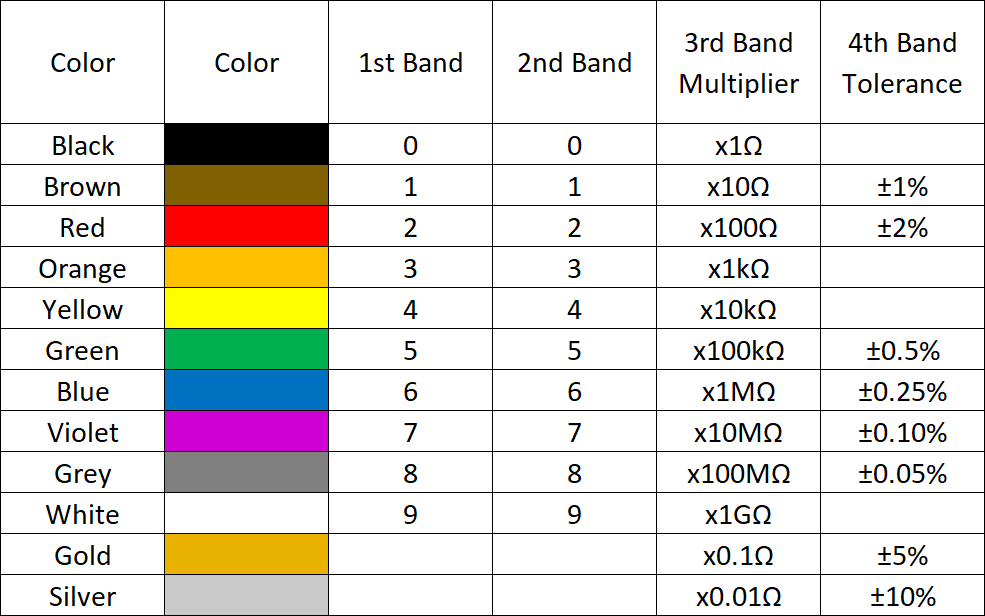
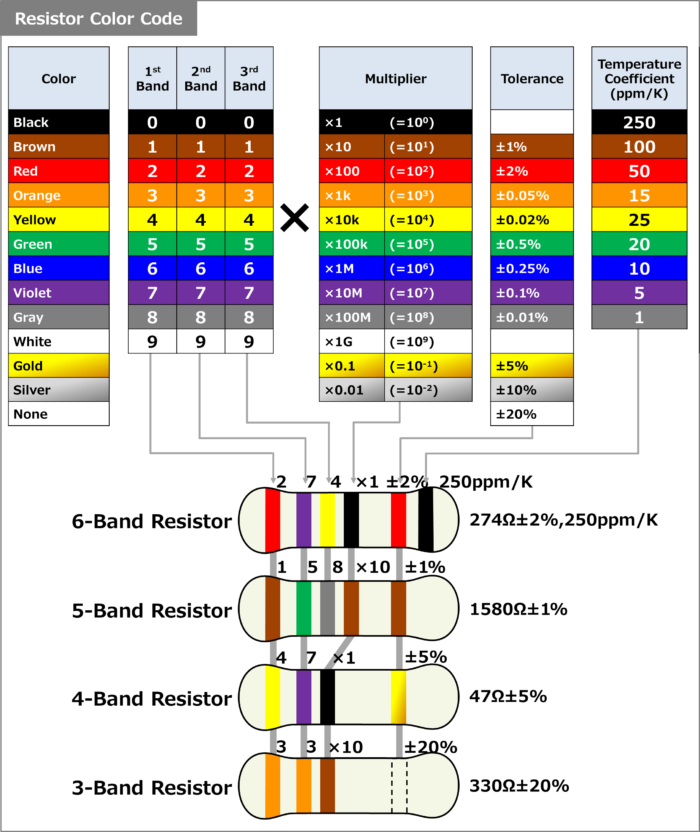
Ceramic and Wirewound Resistors:
Ceramic and wirewound resistors are capable of dissipating more heat. For decoding their value, the resistance is usually printed directly on them.
SMD Resistors:
An SMD (Surface Mount Device) resistor is an electronic component designed to be mounted directly onto the surface of a printed circuit board (PCB), without requiring through-holes. SMD resistors are widely used in modern electronics due to their small size, ease of automated assembly, and performance.
Formulas for Series and Parallel Connections:
-
Series Connection:
R_total = R_1 + R_2 + R_3 +...
-
Parallel Connection:
1/R_total =1/R_1 + 1/R_2 + 1/R_3 +...
Variable Resistors:
These include:
Potentiometers: A potentiometer is an electronic component used to adjust electrical resistance variably. It is often used to control parameters such as audio volume, screen brightness, or motor speed.
Thermistors: Thermistors are electronic components whose resistance varies with temperature. They are used to measure, control, or compensate for temperature variations in various systems.
Photoresistors (LDRs): Photoresistors, also called LDRs (Light Dependent Resistors) or photoconductive cells, are electronic components whose resistance varies with light intensity. They are commonly used to detect light and are often integrated into automatic lighting control systems.
MOV (Metal Oxide Varistors): MOVs (Metal Oxide Varistors) are electronic components used to protect circuits against transient voltage surges. They act as "lightning rods" for electronic equipment, absorbing voltage spikes and preventing damage to sensitive components. Below is a detailed explanation of their operation, characteristics, and applications.
Operation: An MOV is a nonlinear component whose resistance varies depending on the applied voltage:
- Under normal conditions: The MOV has a very high resistance and allows only negligible current to pass.
- During a voltage surge: When the voltage exceeds a certain threshold (called the breakdown voltage), the resistance of the MOV drops sharply, allowing current to pass and dissipate the surge energy.
Once the surge is dissipated, the MOV returns to its initial state, provided the surge did not exceed its capacity limits.
See other component: